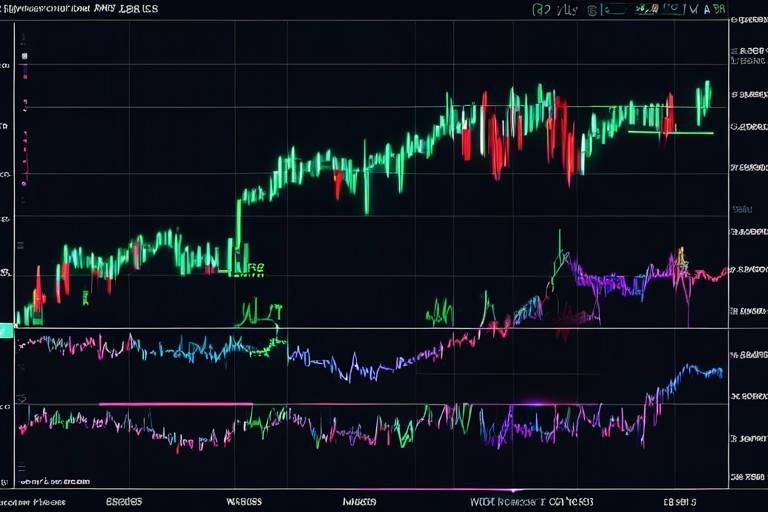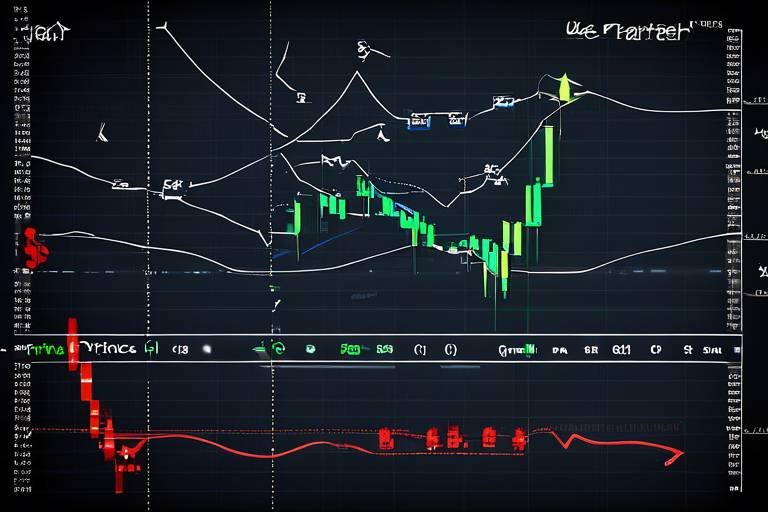How to Identify Long-Term Trends in Cryptocurrency Markets
In the fast-paced world of cryptocurrencies, identifying long-term trends can feel like navigating a maze blindfolded. With prices that can swing wildly from one day to the next, how can investors make sense of it all? The key lies in understanding market behavior, analyzing various indicators, and utilizing the right tools. In this article, we will explore effective strategies for recognizing and analyzing long-term trends in cryptocurrency markets, providing insights that can aid investors in making informed decisions. By the end, you'll have a clearer picture of how to approach this complex landscape and potentially increase your chances of success.
Market cycles are the heartbeat of cryptocurrency trends. Just like the changing seasons, markets go through periods of expansion and contraction. Recognizing these cycles helps investors anticipate shifts in market sentiment and price movements, allowing for better investment timing and strategy formulation. Think of it as a rollercoaster ride: there are ups and downs, but with the right knowledge, you can brace yourself for the next big drop or ascent. Historically, the cryptocurrency market has experienced four main phases: accumulation, uptrend, distribution, and downtrend. Understanding where the market is in this cycle can significantly influence your investment decisions.
Several indicators can signal long-term trends in cryptocurrency markets. By monitoring metrics such as moving averages, volume trends, and market sentiment, investors can gain valuable insights into potential future movements. For instance, a sudden increase in trading volume might indicate that a price surge is on the horizon. Similarly, aligning moving averages can reveal whether a bullish or bearish trend is developing. It's essential to keep an eye on these indicators, as they serve as your compass in the often unpredictable crypto waters.
Technical analysis tools, including charts and patterns, are your best friends when it comes to identifying long-term trends. Utilizing these tools enhances an investor's ability to predict price movements and make strategic investment decisions based on historical data. For example, a chart displaying a consistent upward trend over several months can suggest a robust bullish sentiment, while erratic price fluctuations might indicate uncertainty. The more familiar you become with these tools, the better equipped you'll be to navigate the complexities of the cryptocurrency market.
Recognizing chart patterns, such as head and shoulders or triangles, can indicate potential trend reversals or continuations. Understanding these patterns is essential for anticipating market behavior and aligning investment strategies accordingly. For instance, a head and shoulders pattern often suggests a reversal from a bullish to a bearish trend, while a triangle pattern may indicate a period of consolidation before a breakout. By mastering these patterns, you can position yourself ahead of the curve and make informed decisions.
Moving averages smooth out price data to identify trends over time. By analyzing short-term and long-term moving averages, investors can better understand market momentum and make informed decisions based on trend direction. For example, when a short-term moving average crosses above a long-term moving average, it can signal a bullish trend, while the opposite may indicate a bearish trend. This simple yet powerful tool can provide clarity in the often chaotic world of cryptocurrency trading.
Sentiment analysis involves gauging market emotions and opinions through social media, news, and forums. Understanding sentiment can provide insights into potential market trends and help investors anticipate shifts in price movements. For instance, a surge in positive tweets about a particular cryptocurrency may signal growing interest and potential price increases. By keeping your finger on the pulse of market sentiment, you can make more informed decisions and potentially capitalize on emerging trends.
Fundamental analysis involves evaluating the underlying factors that influence cryptocurrency values. By examining technology, regulatory developments, and market adoption, investors can identify long-term trends that may impact future prices. For instance, a new technological advancement that improves transaction speed or reduces fees could drive demand for a cryptocurrency, leading to price appreciation. Similarly, regulatory clarity can enhance investor confidence, paving the way for broader adoption and higher valuations.
Regulatory changes can significantly impact cryptocurrency markets. Staying informed about new regulations and government policies is essential for understanding their effects on market trends and investor behavior. For example, a country announcing favorable regulations for cryptocurrencies might lead to a price spike, while stricter regulations could cause a downturn. Being aware of these developments allows you to adjust your investment strategy accordingly and avoid potential pitfalls.
Technological innovations within the cryptocurrency space can drive long-term trends. Monitoring advancements such as scalability solutions and new blockchain technologies helps investors gauge potential market shifts and investment opportunities. For instance, the introduction of a new protocol that enhances transaction speeds could lead to increased adoption and, consequently, higher prices. Keeping an eye on these technological trends is crucial for staying ahead in the competitive crypto landscape.
- What are the best indicators for identifying long-term trends in cryptocurrency?
Some of the best indicators include moving averages, trading volume, and market sentiment analysis, as they provide insights into market momentum and potential price movements.
- How can I use technical analysis to make better investment decisions?
By analyzing charts and recognizing patterns, you can identify potential trend reversals or continuations, enabling you to make more informed investment choices.
- Why is sentiment analysis important in cryptocurrency trading?
Sentiment analysis helps gauge market emotions and opinions, allowing you to anticipate potential price movements based on collective market sentiment.
- How do regulatory developments affect cryptocurrency prices?
Regulatory changes can either boost or hinder investor confidence, leading to significant price fluctuations based on the perceived stability and legitimacy of the market.

Understanding Market Cycles
Market cycles are the heartbeat of the cryptocurrency landscape, and understanding them is crucial for anyone looking to make a mark in this volatile arena. Just like the changing seasons, the cryptocurrency market experiences various phases that can significantly impact investment strategies. Have you ever noticed how winter can turn to spring, bringing new life and opportunities? Similarly, recognizing these cycles can help investors anticipate shifts in market sentiment and price movements. By familiarizing yourself with these cycles, you can position yourself to make informed decisions, rather than reacting impulsively to market fluctuations.
At the core of market cycles are four primary phases: accumulation, uptrend, distribution, and downtrend. Each phase has its own characteristics and signals that can provide valuable insights into future price movements. Let’s break them down:
| Market Phase | Description | Investor Behavior |
|---|---|---|
| Accumulation | This phase occurs after a downtrend, where savvy investors begin to buy at lower prices, anticipating a future price increase. | Investors are cautious but optimistic, slowly entering the market. |
| Uptrend | During this phase, prices rise as more investors enter the market, driven by optimism and positive news. | Investors are enthusiastic, often leading to FOMO (Fear of Missing Out). |
| Distribution | As prices peak, early investors start to sell, leading to a slowdown in momentum. This phase can be tricky as sentiment shifts. | Investors may become cautious, watching for signs of a downturn. |
| Downtrend | In this phase, prices decline as fear takes over, often leading to panic selling. | Investors may feel disheartened, leading to a mass exit from the market. |
Recognizing these phases can help you time your investments. For instance, if you spot signs of accumulation, it might be the perfect moment to enter the market. On the flip side, if you notice the distribution phase, it could be wise to consider taking profits or even exiting your position altogether. But how do you identify these phases? One way is to keep an eye on market sentiment and trading volume. A surge in volume during an uptrend can signal strong bullish sentiment, while declining volume during a downtrend might indicate a lack of interest.
Moreover, it's important to remember that market cycles aren’t always linear. They can be influenced by external factors like news events, regulatory changes, or technological advancements. Just like a storm can disrupt a sunny day, unforeseen events can alter the course of market cycles. Therefore, staying informed and flexible in your approach is key to navigating these turbulent waters.
In conclusion, understanding market cycles is not just about recognizing patterns; it's about developing a keen sense of market dynamics. By embracing this knowledge, you can enhance your investment strategy, making it not just reactive, but proactive. So, the next time you consider entering or exiting a position, think about where we are in the market cycle and how it might influence your decisions. After all, in the world of cryptocurrency, timing can be everything!
Q: How long do market cycles typically last?
A: Market cycles can vary in duration, often lasting anywhere from a few weeks to several months or even years, depending on market conditions and external influences.
Q: Can market cycles be predicted?
A: While it's challenging to predict the exact timing of market cycles, understanding historical patterns and current market sentiment can provide valuable insights.
Q: What role does news play in market cycles?
A: News can significantly impact investor sentiment and market cycles, often leading to rapid changes in price and behavior.

Key Indicators to Monitor
When diving into the world of cryptocurrency, it's essential to keep an eye on various key indicators that can provide valuable insights into long-term market trends. These indicators serve as signposts, guiding investors through the often tumultuous and unpredictable landscape of digital currencies. By understanding and monitoring these metrics, you can position yourself to make more informed investment decisions.
One of the most critical indicators to watch is the moving average. Moving averages help smooth out price fluctuations, allowing investors to identify the underlying trend direction over a specific period. Short-term moving averages can reveal immediate trends, while long-term moving averages provide a broader view of market momentum. For example, when a short-term moving average crosses above a long-term moving average, it may signal a bullish trend, while the opposite could indicate a bearish trend.
Another vital indicator is trading volume. Volume reflects the number of coins being traded over a set period and can indicate the strength of a price movement. High trading volume often accompanies significant price changes, suggesting strong market interest and momentum. Conversely, low trading volume during a price move may indicate a lack of conviction among traders, hinting that the trend may not be sustainable.
Additionally, market sentiment plays a crucial role in understanding long-term trends. By analyzing social media chatter, news articles, and forum discussions, investors can gauge the general mood of the market. Are people feeling optimistic or pessimistic? Is there a buzz around a particular cryptocurrency? Tools that aggregate sentiment data can provide a clearer picture of how market participants feel, which can be a leading indicator of price movements.
To further illustrate the importance of these indicators, consider the following table that summarizes each key indicator along with its significance:
| Indicator | Significance |
|---|---|
| Moving Averages | Helps identify the trend direction over time. |
| Trading Volume | Indicates the strength of price movements. |
| Market Sentiment | Reflects the overall mood and confidence of investors. |
Incorporating these indicators into your investment strategy can significantly enhance your ability to identify long-term trends. However, it's important to remember that no single indicator should be used in isolation. Instead, consider using a combination of these metrics to form a comprehensive view of the market. This approach will allow you to make well-rounded decisions and adapt your strategy based on changing market conditions.
Ultimately, monitoring key indicators is akin to having a map in uncharted territory. It provides direction and clarity, helping you navigate the complexities of the cryptocurrency market with greater confidence. So, the next time you analyze potential investments, remember to keep these indicators in your toolkit!
What are moving averages and why are they important?
Moving averages are statistical calculations that help smooth out price data to identify trends over a certain period. They are critical because they help investors determine the direction of the market and make informed decisions based on historical data.
How does trading volume affect price movements?
Trading volume indicates the number of assets being bought and sold. High trading volume can confirm the strength of a price movement, while low volume may suggest a lack of conviction, potentially leading to price reversals.
What is market sentiment and how can I measure it?
Market sentiment refers to the overall attitude of investors toward a particular cryptocurrency. It can be measured through social media analysis, news coverage, and community discussions. Tools that aggregate sentiment data can provide insights into market emotions.

Technical Analysis Tools
When it comes to navigating the complex world of cryptocurrency, are your best friends. These tools help investors dissect price movements, identify patterns, and predict future price trajectories. Think of them as a compass in the vast ocean of market data, guiding you towards informed investment decisions. By utilizing these tools, you can enhance your ability to recognize long-term trends, which is crucial for any serious investor looking to thrive in the cryptocurrency space.
One of the primary tools in technical analysis is charts. Charts visually represent price movements over time, allowing investors to spot trends at a glance. Different types of charts, such as line charts, bar charts, and candlestick charts, each provide unique insights. For instance, candlestick charts not only show price movements but also give context on market sentiment through the color and shape of the candles. This is akin to reading a story; each candle tells a part of the market's narrative.
Another essential aspect of technical analysis is understanding chart patterns. Recognizing patterns like head and shoulders, double tops, and triangles can give you a significant edge. These patterns often indicate potential trend reversals or continuations, allowing you to align your investment strategies accordingly. For example, a head and shoulders pattern might suggest that a bullish trend is about to reverse, signaling it might be time to reevaluate your position. The following table summarizes some common chart patterns and their implications:
| Chart Pattern | Indication |
|---|---|
| Head and Shoulders | Potential trend reversal from bullish to bearish |
| Double Top | Bearish reversal signal |
| Triangle | Continuation pattern, breakout expected |
| Flag | Short-term trend continuation |
Moving averages are another critical component of technical analysis. They help smooth out price data to identify trends over time. By analyzing both short-term and long-term moving averages, you can gain a clearer understanding of market momentum. For instance, if the short-term moving average crosses above the long-term moving average, it can indicate a bullish trend, whereas the opposite crossover might suggest a bearish trend. This technique is often referred to as a "moving average crossover," and it's a powerful signal for traders.
In addition to charts and moving averages, volume analysis is vital. Volume refers to the number of coins traded over a specific period, and it can provide insights into market strength. For example, a price increase accompanied by high volume suggests strong buyer interest, while a price increase with low volume might indicate a lack of conviction. Thus, monitoring volume trends can help you filter out false signals and focus on genuine market movements.
Lastly, don't overlook the importance of indicators. Tools like the Relative Strength Index (RSI), Moving Average Convergence Divergence (MACD), and Bollinger Bands can provide additional layers of analysis. These indicators can help you gauge whether a cryptocurrency is overbought or oversold, offering crucial insights into potential corrections or rallies. In essence, they act as a magnifying glass, allowing you to zoom in on specific market conditions that might otherwise go unnoticed.
In summary, mastering technical analysis tools is essential for anyone looking to identify long-term trends in cryptocurrency markets. By effectively utilizing charts, recognizing patterns, analyzing volume, and employing indicators, you can make more informed decisions. Remember, the market is not just about numbers; it's about understanding the story behind those numbers and using that knowledge to your advantage.
- What is technical analysis? Technical analysis involves analyzing price movements and market data to forecast future price trends.
- How do I start using technical analysis? Begin by familiarizing yourself with charts, patterns, and indicators. Practice analyzing historical data to gain confidence.
- Are technical analysis tools reliable? While they can provide valuable insights, no tool is foolproof. It's essential to combine technical analysis with other forms of analysis for better accuracy.
- Can I use technical analysis for any cryptocurrency? Yes, technical analysis can be applied to any cryptocurrency, but the effectiveness may vary based on market conditions.

Chart Patterns
Chart patterns are like the fingerprints of the market—they tell a story about what has happened and what might happen next. By recognizing these patterns, investors can make educated guesses about future price movements. Think of chart patterns as the map that guides you through the often-turbulent waters of cryptocurrency trading. They come in various shapes and sizes, each with its own implications for price action. Some of the most common patterns include the head and shoulders, double tops and bottoms, and triangles. Understanding these formations can be crucial for anticipating market behavior and aligning your investment strategies accordingly.
For instance, the head and shoulders pattern typically signals a reversal in trend. It forms when the price creates three peaks: a higher peak (the head) between two lower peaks (the shoulders). When this pattern appears, it often indicates that a bullish trend may be coming to an end, and a bearish trend could be on the horizon. On the other hand, the double top and double bottom patterns suggest that the price has reached a significant resistance or support level, respectively, and may be poised for a reversal. Recognizing these patterns can be the difference between making a profitable trade and suffering a loss.
Another essential pattern to watch is the triangle formation, which can be either ascending, descending, or symmetrical. Triangles indicate a period of consolidation where the price is narrowing within a range. This pattern often precedes a breakout, which can lead to significant price movements. The key is to wait for the breakout direction—whether it’s bullish or bearish—before making your move.
| Chart Pattern | Description | Implication |
|---|---|---|
| Head and Shoulders | Three peaks: one higher (head) between two lower (shoulders) | Potential trend reversal from bullish to bearish |
| Double Top | Two peaks at roughly the same price level | Possible reversal from bullish to bearish |
| Double Bottom | Two troughs at roughly the same price level | Possible reversal from bearish to bullish |
| Triangles | Price consolidates into a tighter range | Potential breakout direction can lead to significant moves |
In summary, chart patterns serve as valuable tools for investors looking to navigate the unpredictable world of cryptocurrency. By mastering the art of pattern recognition, you can enhance your ability to predict price movements and make more informed investment decisions. Remember, though, that while these patterns can provide insights, they are not foolproof. Always combine them with other forms of analysis to create a well-rounded investment strategy.
- What is the significance of chart patterns in cryptocurrency trading?
Chart patterns help traders identify potential price movements and reversals, enabling them to make informed decisions. - Can chart patterns guarantee profits?
No, while they can indicate potential trends, they are not foolproof and should be used in conjunction with other analysis methods. - How can I learn to recognize chart patterns?
Practice is key! Use historical charts to identify patterns and consider using trading simulators to hone your skills.

Moving Averages
When it comes to navigating the turbulent waters of cryptocurrency markets, serve as one of the most reliable compasses available to investors. Essentially, a moving average is a statistical calculation that helps smooth out price data by creating a constantly updated average price. This technique is particularly useful in the volatile world of cryptocurrencies, where price swings can be as dramatic as a roller coaster ride.
There are two primary types of moving averages that investors often rely on: the simple moving average (SMA) and the exponential moving average (EMA). The SMA calculates the average price over a specific number of periods, giving equal weight to all prices in that range. In contrast, the EMA places greater emphasis on more recent prices, making it more responsive to changes in market trends. This distinction is crucial, as it can significantly affect trading signals and investment decisions.
To illustrate how moving averages can influence your investment strategy, let’s consider a hypothetical scenario. Imagine you’re monitoring Bitcoin’s price over a 50-day period. If the current price is above the 50-day SMA, it might indicate a bullish trend, suggesting that it could be a good time to buy. Conversely, if the price falls below the SMA, it could signal a bearish trend, prompting you to consider selling or holding off on new purchases. This simple yet powerful tool can help you make more informed decisions based on market momentum.
Furthermore, traders often look for crossovers between moving averages as key indicators. A common strategy involves using two moving averages: a shorter one, like the 20-day EMA, and a longer one, such as the 50-day SMA. When the shorter EMA crosses above the longer SMA, it’s often seen as a bullish signal, while a crossover in the opposite direction can indicate a bearish trend. This technique allows investors to capitalize on potential price movements, making it a valuable addition to any trading strategy.
To sum up, moving averages are not just numbers on a chart; they represent a powerful method for understanding market trends and making informed investment choices. By incorporating moving averages into your analysis, you can gain a clearer picture of market momentum and potential price shifts, ultimately enhancing your trading strategy.

Sentiment Analysis
Sentiment analysis is a fascinating yet crucial aspect of understanding cryptocurrency markets. It involves gauging the emotions and opinions of market participants, which can provide invaluable insights into potential price movements. Think of it as taking the market's pulse; just like a doctor checks your heartbeat to assess your health, investors use sentiment analysis to evaluate the overall mood of the market. By tapping into various sources such as social media platforms, news articles, and online forums, one can gather a wealth of information that reflects how traders and investors feel about specific cryptocurrencies.
For instance, if a prominent figure in the crypto space shares a positive tweet about a particular coin, you might see a spike in its price. Conversely, negative news can cause panic selling and a sharp decline in value. This is why keeping an ear to the ground and monitoring sentiment is so vital. Investors can use sentiment analysis to identify trends before they become apparent in the price charts, allowing for more strategic decision-making.
Here are some key sources and methods for conducting effective sentiment analysis:
- Social Media Monitoring: Platforms like Twitter and Reddit are goldmines for real-time sentiment. Tools like Hootsuite or TweetDeck can help track mentions and hashtags related to a specific cryptocurrency.
- News Aggregators: Websites such as CoinDesk and CoinTelegraph provide comprehensive news coverage that can influence market sentiment. Keeping up with the latest developments can give you an edge.
- Sentiment Analysis Tools: There are specialized tools like Cryptometer and Santiment that analyze social media sentiment and provide metrics that can forecast market movements.
However, it’s essential to approach sentiment analysis with a critical eye. Not all sentiment is created equal, and sometimes, the loudest voices may not represent the majority opinion. Therefore, combining sentiment analysis with other forms of analysis—like technical and fundamental analysis—can lead to a more balanced view of the market. By understanding how emotions drive market behavior, investors can position themselves to capitalize on opportunities that others might miss.
In summary, sentiment analysis is not just about gathering data; it’s about interpreting that data to make informed investment decisions. By being attuned to the emotional landscape of the cryptocurrency market, you can enhance your ability to predict price movements and align your investment strategies accordingly.
Q: What is sentiment analysis in cryptocurrency?
A: Sentiment analysis in cryptocurrency involves evaluating the emotions and opinions of market participants through various sources like social media and news articles to gauge market trends.
Q: Why is sentiment analysis important?
A: It helps investors anticipate market movements and make more informed investment decisions by understanding the prevailing emotions surrounding a cryptocurrency.
Q: What tools can I use for sentiment analysis?
A: Tools like Hootsuite, CoinDesk, and specialized sentiment analysis platforms like Cryptometer and Santiment can be very useful.
Q: Can sentiment analysis predict market trends?
A: While sentiment analysis can provide insights into potential trends, it should be used in conjunction with other analytical methods for the best results.

Fundamental Analysis Factors
When diving into the world of cryptocurrency, fundamental analysis is like having a treasure map. It helps you uncover the underlying factors that influence the value of various cryptocurrencies. While many investors may focus solely on price charts and market trends, understanding these fundamental elements can provide a more comprehensive view of potential long-term trends. So, what exactly should you be looking for?
First and foremost, technology plays a pivotal role in shaping the future of cryptocurrencies. The blockchain technology behind each coin is not just a buzzword; it’s the backbone that determines its scalability, security, and utility. For instance, cryptocurrencies like Ethereum are continuously evolving with upgrades that enhance their smart contract capabilities, making them more attractive for developers and users alike. Keeping an eye on technological advancements can give you a competitive edge in predicting which coins might surge in value.
Next up is regulatory developments. Imagine trying to play a game where the rules keep changing. That’s what investing in cryptocurrencies can feel like without understanding the regulatory landscape. Governments around the world are continuously crafting new laws that can either bolster or hinder the growth of cryptocurrencies. For example, when a country announces favorable regulations, it often leads to a price spike as investors flock to capitalize on the new opportunities. Conversely, harsh regulations can lead to market panic and sell-offs. Therefore, staying updated on regulatory news is crucial for any serious investor.
Another fundamental aspect to consider is market adoption. The more widely a cryptocurrency is accepted for transactions, the more its value can potentially increase. Think of it like this: if everyone starts using a particular currency for their daily transactions, its demand will rise, driving up its price. You can gauge market adoption by looking at partnerships, integrations with payment platforms, and the growing number of merchants accepting cryptocurrencies. Additionally, social acceptance and community engagement can serve as indicators of a cryptocurrency's long-term viability.
To further illustrate these factors, let’s take a look at a simple table comparing different cryptocurrencies based on their technological advancements, regulatory environments, and market adoption:
| Cryptocurrency | Technology | Regulatory Environment | Market Adoption |
|---|---|---|---|
| Bitcoin | Established, limited scalability | Varies by country | Widely accepted |
| Ethereum | Upgrades for scalability (e.g., ETH 2.0) | Increasingly favorable | Growing developer community |
| Ripple (XRP) | Focus on cross-border payments | Legal challenges in the US | Partnerships with banks |
In conclusion, understanding fundamental analysis factors is essential for anyone looking to navigate the ever-evolving cryptocurrency landscape. By keeping a close eye on technology, regulations, and market adoption, you can better position yourself to identify long-term trends and make informed investment decisions. Remember, the world of crypto is not just about numbers; it’s about understanding the story behind each coin.
- What is fundamental analysis in cryptocurrency? Fundamental analysis involves evaluating the underlying factors that influence the value of cryptocurrencies, such as technology, regulations, and market adoption.
- Why is technology important in crypto investing? Technology determines the scalability, security, and utility of a cryptocurrency, which can significantly impact its long-term value.
- How do regulatory changes affect cryptocurrency prices? Regulatory changes can either boost or hinder market confidence, leading to price fluctuations based on investor sentiment.
- What should I monitor for market adoption? Look for partnerships, integrations with payment systems, and the number of merchants accepting a cryptocurrency to gauge its adoption.

Regulatory Developments
When it comes to the world of cryptocurrency, are like the weather—constantly changing and often unpredictable. Just as a sudden storm can disrupt your plans, new regulations can shake up the crypto market, leading to significant price fluctuations and shifts in investor sentiment. Understanding these regulations is crucial for anyone looking to navigate the tumultuous waters of cryptocurrency investment.
Regulatory bodies around the world are increasingly focusing on cryptocurrencies, aiming to create frameworks that protect investors while also fostering innovation. This dual approach can sometimes create a tightrope walk for investors. On one hand, clear regulations can lead to greater market stability and trust, encouraging more people to enter the space. On the other hand, overly stringent regulations can stifle innovation and limit the growth potential of cryptocurrencies.
For instance, in the United States, the Securities and Exchange Commission (SEC) has been particularly active in scrutinizing Initial Coin Offerings (ICOs) and classifying certain cryptocurrencies as securities. This classification can lead to increased compliance costs for projects, which may deter new entrants into the market. Conversely, countries like El Salvador have embraced cryptocurrencies, even adopting Bitcoin as legal tender, creating a unique environment that attracts investors and innovators alike.
To help you understand the impact of regulatory developments, consider the following key points:
- Market Sentiment: Regulatory news can significantly influence market sentiment. Positive developments, such as the approval of a Bitcoin ETF, can lead to bullish trends, while negative news, like crackdowns on exchanges, can cause panic selling.
- Investment Strategies: Investors need to adapt their strategies based on regulatory changes. Keeping abreast of new laws can help you make informed decisions about when to buy or sell.
- Global Perspective: Different countries have different approaches to regulation. Understanding the global landscape can provide insights into where the best opportunities may lie.
Moreover, it's essential to monitor the impact of regulations on specific cryptocurrencies. For example, a new regulation targeting privacy coins may lead to a decline in their value, while regulations favoring decentralized finance (DeFi) could enhance the appeal of those platforms. Thus, staying updated on regulatory news can be a game-changer for your investment portfolio.
In conclusion, regulatory developments are a critical factor in identifying long-term trends in the cryptocurrency market. By keeping an eye on the evolving legislation and understanding its implications, investors can better position themselves to capitalize on opportunities while mitigating risks. So, the next time you hear about a new regulation, don’t just brush it off—consider how it might affect your investments and the broader market landscape.
Q: How do regulatory developments affect cryptocurrency prices?
A: Regulatory developments can lead to increased investor confidence or fear, directly impacting cryptocurrency prices. Positive regulations may boost prices, while negative news can lead to declines.
Q: Should I invest in cryptocurrencies that are heavily regulated?
A: It depends on your investment strategy. Heavily regulated cryptocurrencies may offer more security but could also face restrictions that limit their growth potential.
Q: How can I stay updated on regulatory changes?
A: Follow reputable news sources, subscribe to cryptocurrency newsletters, and join online forums to keep abreast of the latest regulatory developments.

Technological Advancements
In the fast-paced world of cryptocurrency, are not just buzzwords; they are the lifeblood of the market. As new technologies emerge, they can significantly influence the way cryptocurrencies operate, thereby shaping long-term trends. For instance, innovations in blockchain technology, such as layer 2 scaling solutions and smart contract enhancements, are paving the way for more efficient and scalable networks. This means that as these technologies mature, they can attract more users and investors, ultimately driving demand and prices upward.
One of the most exciting developments in the crypto space is the advent of decentralized finance (DeFi). By leveraging smart contracts, DeFi platforms allow users to engage in financial transactions without intermediaries, creating a more inclusive financial ecosystem. This shift is not just a trend; it's a fundamental change in how we think about finance. As DeFi continues to grow, it opens up new investment opportunities, making it crucial for investors to stay informed about the latest advancements.
Moreover, the rise of non-fungible tokens (NFTs) has transformed the way we perceive ownership and value in the digital realm. NFTs are unique digital assets that represent ownership of a specific item or piece of content, and their popularity is reshaping the art, gaming, and entertainment industries. As these technologies evolve, they can create entirely new markets, offering investors a chance to capitalize on emerging trends.
It's also essential to consider the role of interoperability among different blockchain networks. Projects that focus on enabling seamless communication between various blockchains can lead to a more integrated ecosystem. This interconnectedness can enhance liquidity and broaden the user base, making it a critical factor for long-term trend identification. Investors should keep an eye on projects that prioritize interoperability, as they are likely to play a significant role in the future of cryptocurrency.
To summarize, technological advancements are a key driver of long-term trends in the cryptocurrency market. By staying updated on innovations in blockchain technology, DeFi, NFTs, and interoperability, investors can gain valuable insights into potential market shifts. Understanding these advancements not only helps in making informed investment decisions but also positions investors to take advantage of new opportunities as they arise.
- What are the key technological advancements in cryptocurrency?
Key advancements include layer 2 scaling solutions, decentralized finance (DeFi), non-fungible tokens (NFTs), and interoperability among blockchains.
- How do technological advancements affect cryptocurrency prices?
Technological advancements can increase efficiency, scalability, and user adoption, leading to higher demand and potentially driving prices up.
- Why is DeFi important in the crypto space?
DeFi allows for financial transactions without intermediaries, creating a more inclusive financial ecosystem and opening up new investment opportunities.
- What role do NFTs play in the cryptocurrency market?
NFTs represent unique digital assets and are reshaping ownership and value perception in various industries, creating new markets for investors.
Frequently Asked Questions
- What are long-term trends in cryptocurrency markets?
Long-term trends in cryptocurrency markets refer to the sustained movements in price and market behavior over extended periods. These trends can be upward, downward, or sideways and are essential for investors looking to make informed decisions. By identifying these trends, investors can align their strategies and potentially capitalize on market shifts.
- How can I recognize market cycles?
Recognizing market cycles involves understanding the phases of market behavior, which typically include accumulation, uptrend, distribution, and downtrend. By studying historical price movements and market sentiment, investors can anticipate shifts and adjust their investment strategies accordingly. Tools like charts and technical indicators can also help in identifying these cycles.
- What key indicators should I monitor for long-term trends?
Key indicators for monitoring long-term trends include moving averages, trading volume, and market sentiment. Moving averages help smooth out price data to reveal the overall trend direction, while volume trends indicate market activity. Additionally, sentiment analysis through social media and news can provide insights into investor emotions and potential market movements.
- What role does technical analysis play in identifying trends?
Technical analysis is crucial for identifying long-term trends as it involves studying historical price data through charts and patterns. By recognizing specific chart patterns, such as head and shoulders or triangles, investors can predict potential trend reversals or continuations. This analysis helps in making strategic investment decisions based on past market behavior.
- Why is sentiment analysis important in cryptocurrency investing?
Sentiment analysis is important because it gauges the emotions and opinions of market participants, which can significantly influence price movements. By analyzing social media, news articles, and forums, investors can gain insights into prevailing market sentiments, helping them anticipate potential shifts in trends and make more informed decisions.
- How do regulatory developments affect cryptocurrency trends?
Regulatory developments can have a profound impact on cryptocurrency markets. New regulations or changes in government policies can alter market dynamics, influencing investor behavior and overall market sentiment. Staying informed about these developments is essential for understanding their effects on long-term trends and potential investment opportunities.
- What technological advancements should I keep an eye on?
Technological advancements in the cryptocurrency space, such as scalability solutions and new blockchain technologies, can drive long-term trends. By monitoring these innovations, investors can identify potential market shifts and investment opportunities that arise from improvements in technology, enhancing the overall utility and adoption of cryptocurrencies.



















